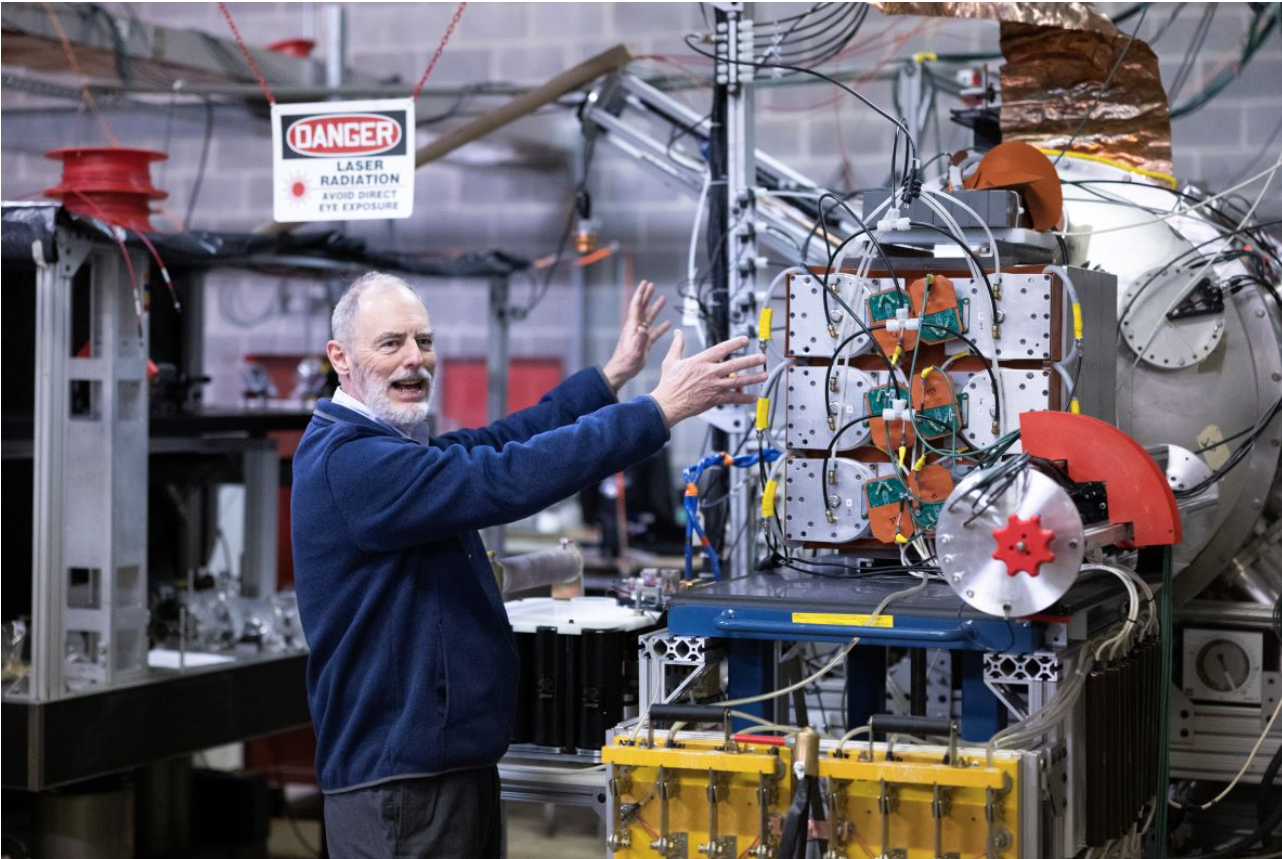Climate Insider had the opportunity to interview Amit Singh (CEO) and Douglas Witherspoon (Founder, President and Chief Scientist) from NearStar Fusion, who shared valuable insights on the technology behind NearStar and the fusion industry in general.
NearStar Fusion’s Unique Approach to Fusion
In 2021, Douglas started NearStar Fusion to explore impact fusion, a concept he found interesting since grad school. The idea was to use an advanced plasma armature railgun to accelerate a projectile at a stationary fusion fuel target, causing a controlled fusion reaction. Originally conceived for fusion spacecraft propulsion, Douglas shifted the concept to fusion energy for commercial power plants. NearStar Fusion’s key innovation is magneto-inertial fusion, using a laser to magnetise the fuel target during impact, confining particles and preventing heat escape. The system uses a stationary target, high-speed projectile, and a molten salt waterfall for energy absorption. Notably, it aims to use deuterium-deuterium (DD) fuel for sustainability, avoiding tritium breeding and supply chain challenges. The system is modular, with the railgun driver using commercial-off-the-shelf components (COTS) for cost-effectiveness. NearStar’s impact fusion concept stands out for its potential to surpass other approaches using DT fuel and exploring secondary burns with fuels like hydrogen-boron-11.
When asked about key features that make the model unique, Amit mentioned the NearStar model works with technology that already exists. “I think the key takeaway is that all the technologies and materials we need already exist. We are not waiting for new magnets or new types of lasers to be developed for us to finish the design. So in a lot of ways, we have the ability to leapfrog a lot of other fusion companies out there,” said Amit. This implies a substantial simplification of the fusion process; the existing availability of required resources positions NearStar Fusion to progress more rapidly and efficiently in the development of their fusion technology.

Moreover, Douglas mentioned another key point that makes the NearStar model unique is the use of deuterium-deuterium (DD) fuel over the more traditional deuterium-tritium (DT) fuel. In explaining the reasoning behind this, Douglas said, “Tritium is not found in nature. You have to actually breed it from other fusion reactors, which means that you have to make a little bit more tritium than you used in the previous shot in order to keep that fusion economy going.” Unlike tritium, which is not found in nature and requires breeding in other fusion reactors, deuterium is abundant and can be extracted from seawater, providing an effectively infinite and cost-efficient supply for millions of years. This fuel choice not only simplifies the fusion process but also avoids the complex and resource-intensive task of breeding tritium, which is crucial for sustaining the fusion economy. The avoidance of tritium-related challenges contributes to the convenience, cost efficiency, and economic viability of NearStar Fusion’s approach, making it a noteworthy advancement in fusion technology.
NearStar Fusion’s Approach Towards Equity
Both Amit and Douglas stressed on the importance of equity when it comes to creating sustainable models and entrepreneurship within climate tech. This includes creation of opportunities and building models using accessible and sustainable technologies and resources. In fact, Amit mentioned that addressing resource scarcity in energy remained one of his motivations behind joining NearStar. “But one thing that irked me is that so many of the world’s problems are rooted in the scarcity of resources, specifically energy. But if there was a way that we could solve the root cause, we would not only solve the problem, but we would also open the door to all kinds of entrepreneurship and space exploration,” said Amit.
The use of fuels and materials that are accessible is another aspect underscoring the value of equity. “The use of deuterium-deuterium fuel is key because when we talk about energy equity in the world, the use of material and fuels available all over the world including third world nations is very important,” said Amit.
The choice of deuterium-deuterium (DD) fuel in NearStar Fusion’s approach is highlighted as a crucial element for achieving energy equity worldwide. By using a fuel that is readily available throughout the entire world, including third-world nations, the approach becomes inherently equitable and accessible. This emphasis on the global availability of deuterium underscores the potential for third-world countries, often facing energy challenges, to participate in and benefit from the fusion technology developed by NearStar. In essence, the use of DD fuel aligns with the goal of making energy solutions widely accessible, promoting equity, and addressing the energy needs of nations across different economic strata.
In connection with principles of equity, Amit and Douglas mentioned that they are keen on building a model and machinery such that they can train present mechanics to use it, instead of having to hire very qualified professionals. If successful, this model could set a precedent around creating opportunities for blue-collar workers in the fusion energy sector. Achieving equity in the deployment of this technology may involve developing training programs that are accessible and inclusive while maintaining the necessary standards for competence and safety.
NearStar Fusion presents a pioneering approach to fusion technology, aiming to revolutionise the field with its emphasis on simplicity, modularity, and practicality. The technology’s modularity, simplicity, and reliance on existing materials position NearStar Fusion to potentially leapfrog other fusion projects, promising a more accessible and equitable future for fusion energy deployment.
To stay informed about the climate industry explore our latest climate news.








